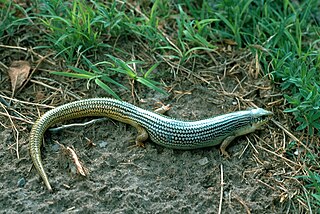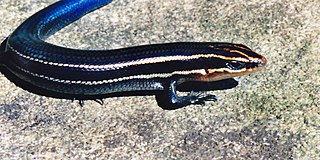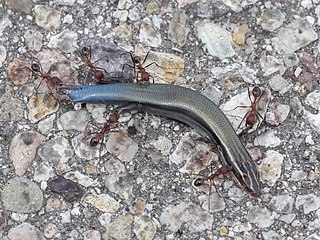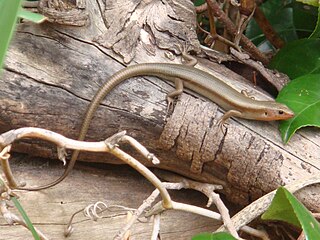
The genus Eumeces comprises four African to Middle-Eastern skink species.

The Florida sand skink is a species of lizard in the family Scincidae, the skinks. It is endemic to Florida in the United States.

The western skink is a species of small, smooth-scaled lizard with relatively small limbs. It measures about 100 to 210 mm in total length. It is one of seven species of lizards in Canada. They spend much of their day basking in the sun. Their diet ranges widely, including spiders and beetles. Western skinks will bite if grasped and will flee if they feel threatened. It is a common but secretive species whose range extends from southern British Columbia and throughout Washington, Oregon, Nevada, Utah, Idaho, and Wyoming and into western Montana and northern Arizona and Missouri. They can also live in some areas of Texas It is widespread in northern California but primarily restricted to the coast in central and southern California. Found in a variety of habitats, this lizard is most common in early successional stages or open areas of late successional stages. Heavy brush and densely forested areas are generally avoided. Western skinks are found from sea level to at least 2,130 m (7,000 ft). This diurnal reptile is active during the warm seasons.

Plestiodon anthracinus, the coal skink, is a species of lizard which is endemic to the United States.

The broad-headed skink or broadhead skink is species of lizard, endemic to the southeastern United States. The broadhead skink occurs in sympatry with the five-lined skink and Southeastern five-lined skink in forest of the Southeastern United States. All three species are phenotypically similar throughout much of their development and were considered a single species prior to the mid-1930s.

Plestiodon gilberti, commonly known as Gilbert's skink, is a species of heavy-bodied medium-sized lizard in the family Scincidae. The species is endemic to the southwestern United States and northwestern Mexico, and grows to about 7 to 12 cm in total length.

The Great Plains skink is a species of lizard endemic to North America.

The prairie skink is a species of skink endemic to the prairies east of the Rocky Mountains in North America. It is one of only seven species of lizards that occur in Canada.

The (American) five-lined skink is a species of lizard in the family Scincidae. The species is endemic to North America. It is one of the most common lizards in the eastern U.S. and one of the seven native species of lizards in Canada.

Plestiodon inexpectatus, the southeastern five-lined skink is a common skink in the southeastern United States.

The four-lined skink is a species of lizard, which is endemic to North America. It is a medium-sized member of the Plestiodon skinks.

Plestiodon callicephalus, commonly known as the mountain skink, is a species of lizard, a medium-sized member of the Plestiodon skinks, endemic to North America.

Plestiodon multivirgatus, commonly known as the many-lined skink, the northern many-lined skink, or the variable skink, is a medium-sized species of lizard, a member of the North American skink genus Plestiodon in the family Scincidae. The species is native to the western United States.
Edwin H. McConkey is an American biologist. As of 2004, he is a professor emeritus at the department for Molecular, Cellular, and Developmental Biology at the University of Colorado at Boulder, Colorado.

Plestiodon is a genus of lizards in the family Scincidae (skinks). The genus contains many species formerly classified under the genus Eumeces, except those now placed in Mesoscincus. They are secretive, agile animals with a cylindrical body covered with smooth, shiny scales. They are distributed from East Asia to throughout North America from southern Canada south to Mexico, including oceanic islands such as Bermuda.

The Lake Wales Ridge National Wildlife Refuge is part of the United States National Wildlife Refuge (NWR) System, located in four separated areas on the Lake Wales Ridge east of US 27 between Davenport and Sebring Florida. The 1,194 acre (4.8 km2) refuge was established in 1990, to protect a host of plants and animals. It is also the first to be designated primarily for the preservation of endangered plants, and is not open to the general public. It contains a high proportion of remaining Florida scrub habitat. It is administered as part of the Merritt Island National Wildlife Refuge.
The Florida peninsula inland scrub is a shrubland community found on the Florida peninsula. The largest remaining blocks of inland scrub are in and around the Ocala National Forest and in the Lake Wales Ridge National Wildlife Refuge. The Archbold Biological Station near Lake Placid contains about 20 km2 (7.7 sq mi) of scrub habitat and sponsors biological research on it. The scrub occurs on a series of north-south running ridges composed of sand derived from ancient dune fields. The soil, a type of entisol, is derived from quartz and is low in organic matter, silt, and clay. Because the low-nutrient sandy soils do not retain moisture, the ecosystem is effectively an arid one.

The Okada's five-lined skink or Far Eastern skink is a species of lizard which is endemic to Japan.

Plestiodon lynxe, also known commonly as the oak forest skink, is a species of lizard in the family Scincidae. The species is endemic to Mexico. There are three recognized subspecies.





















